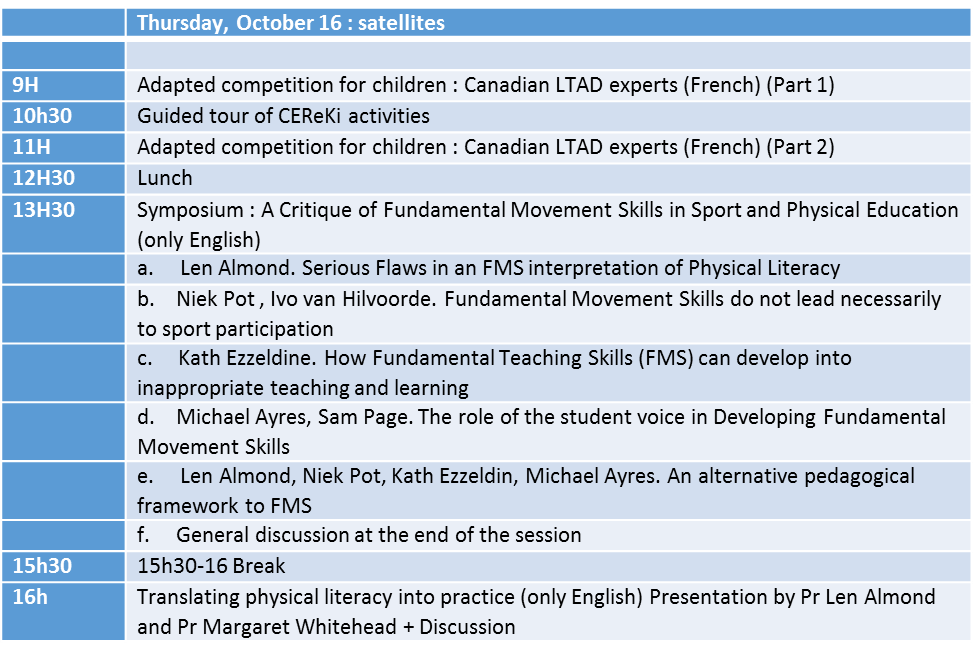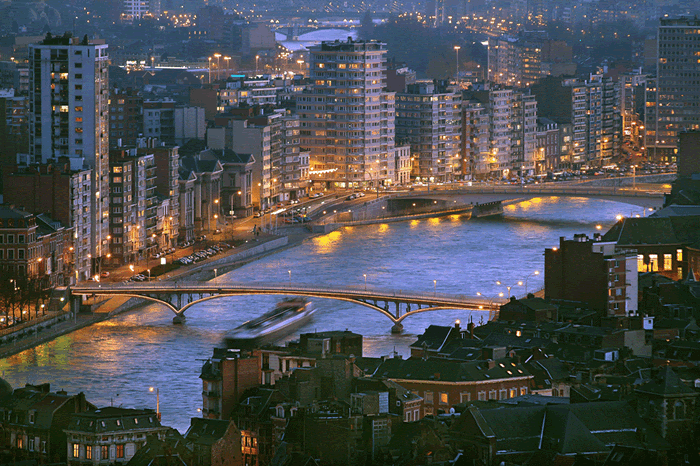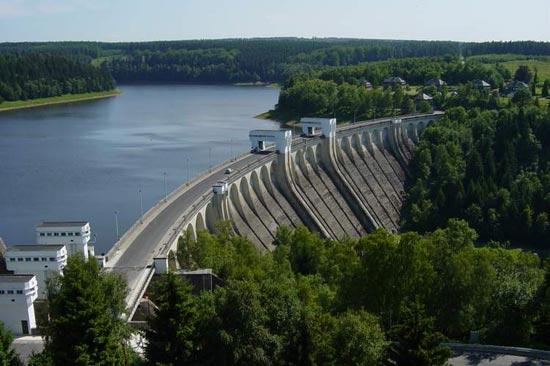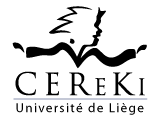Presentation

The International Congress on Children's Physical Activity and Sport will take place from 17 to 18 October 2014 at the University of Liege, Liege, Belgium.
Organised to mark the 25th anniversary of CEReKI, this international congress can be considered as an extension of the 1st European Congress on Physical Activity and Health among 0-6 years old Children which was organised in 2010 in Epinal (France).
Reflections and discussions will focus on the key period between three and nine years, when children start to take part in organised physical and sporting activities. The challenges within this age range are crucial because this is when relevant and appropriate practice can establish the solid foundations which children need to encourage them to take pleasure in sport and to practice physical activity in the long term.
This congress is a unique opportunity to meet international experts and to share your knowledge, experience and skills through oral presentations, posters and videos.
Liege is known for its hospitality. Congress participants and those accompanying them will be warmly welcomed by the University, the City and the Province of Liege and will have the opportunity to discover the richness of this historical and cultural town situated at the heart of Europe.
We look forward to seeing you soon in Liege.
Kind regards
Pr Boris Jidovtseff
Organising comittee chairman
Topics
Objectives and themes
The aim of this congress is to bring together scientific and front-line specialists interested in the same question: children's physical activity and sport. Organised to mark the anniversary of CEReKI, this international congress aims to offer pragmatic discussions which will encourage participants to reflect and act. A significant part of the presentations and discussions will focus on children's long-term development, including both competitive and recreational physical activity. The challenge is to reduce sedentary behaviour and, above all, to develop children's enthusiasm for physical activity and sport by offering appropriate teaching which takes into account the child's particularities, their specific context and individual character. Particular attention will be paid to the issues raised by the Canadian concept of LTAD (Long Term Athlete Development), such as the risk of specialising too early, interest in multiple sports and models of competition for young people.
Themes
Three major questions will be addressed throughout the congress :
How important is physical activity during childhood for encouraging a lifetime of physical activity or sport?
By addressing this question, contributions will attempt to underline the impact of physical activity on children's overall development and their future involvement in one or more sports.
What factors encourage or discourage children's physical activity and their future involvement in sport?
A number of factors can encourage or discourage the long term practice of physical or sporting activity: changes in society, cultural context, an increase in sedentary behaviour, existing facilities, the role of parents and teachers, the medical world, clubs and federations, and the influence of local and regional policies. In a system which is both complex and multifaceted, how can we make a real impact upon young people's long term involvement in sport?
What type of activity should children undertake and how can long term involvement be encouraged?
Both the content of sports sessions as well as way in which they are taught must be adapted to children. What strategies should be adopted in schools, clubs or at home? The concept of taking pleasure in activity is certainly a key element leading to an increase in the rate of physical activity. In addition, seeking sporting excellence at an early age, as seen in several sports raises questions: should children specialise at an early age? Are competitions adapted to children? How can injuries, overload and loss of motivation be avoided? Is the search for sporting excellence compatible with development of activities for all?
Sessions and Topics
Session 1 : The importance of physical activity, motor skills development and risks of sedentary behaviour during childhood
- The impact of physical activity and the risks of sedentary behaviour on the development of healthy children.
- The impact of physical activity and the risks of sedentary behaviour on special needs children development.
- Evaluation of the level of physical activity/sedentary behaviour in children.
- Evaluation of motor skill and relationships with children development.
Session 2 : Factors which encourage/discourage physical activity during childhood
- Social and environmental elements which encourage/discourage physical activity and sport.
- Psychological elements which encourage/discourage physical activity and sport.
- Physiological elements which encourage/discourage physical activity and sport.
- The role and impact of parents, trainers, medical staff and politics.
Session 3 : What type of activity should children undertake and how can long term involvement be encouraged?
- Modele of activities which are adapted to children.
- Models of competition which are adapted to children.
- Pedagogical and strategic approaches to encourage long term involvement.
- When and how to specialise in a sport ?
- How to encourage long term involvement in sport for all ?
- Training load, overtraining and injuries during children physical activity and sport.
Keynote speakers
Prof. Arja Sääkslahti, University of Jyväskylä, Finland
"The keys for a successful physical activity during childhood"
(Les clés d'une activité physique réussie durant l'enfance)
Prof. Greet Cardon, Ghent University, Belgium
"More physical activity and less sitting in children: why and how?"
(Plus d'activité physique et moins de passivité durant l'enfance : Pourquoi et comment ?)
Prof. Jean Côté, Queen's University, Kingston, Canada
"Seven postulates about youth sport activities that lead to continued participation and elite performance"
(Sept postulats sur l'activité sportive chez les jeunes qui favorisent l'activité à long terme et l'excellence sportive)
Prof. Charles Cardinal, University of Montreal, Canada
"Développement du savoir-faire physique et réflexion critique sur la structure et le format des compétitions chez les enfants"
(The importance of physical literacy for children involved in sports and a critical reflexion on the competition structure and format)
Programme

Full programme here{phocadownload view=file|id=32|target=s}
Satellites
Registration for SATELLITES here : https://my.ulg.ac.be/portail/go_xt.do?a=o%7C11004%7Ce%7C181793

CEReKi guided Tour : have a look on our video : http://www.ulg.ac.be/cms/c_4196175/en/a-story-of-fundamental-motor-education
Call for Paper
ABSTRACTS OF PAPERS WILL BE PUBLISHED IN A SPECIAL EDITION OF "SCIENCE & SPORTS" (IMPACT FACTOR = 0.49)
NEW DEADLINE : MAY 1st !!!
Any scientific research, implemented project, or front-line experience which corresponds to the congress theme and sessions may be presented. Three types of papers are possible: oral presentation; poster presentation; video presentation.
Abstracts of papers must be submitted before 1st May 2014, and must comply strictly with the following editorial instructions:
1. Title: Arial bold 14. Maximum two lines
2. Authors: Arial 12. Initial(s) of first name followed by family name. Authors' names are separated by a comma
3. Affiliation: Arial narrow 11. Service or department and name of establishment
4. Text: maximum 300 words in Arial 10, headings in bold. The structure should be adapted to the type of presentation
FOR SCIENTIFIC RESEARCH : (model)
Introduction: short introduction and main objective of the study
Methods: subjects, material and method, data analysis
Results: summary of the main results and discussion
Conclusions: the main conclusions of the study, implications and/or outlook
FOR IMPLEMENTED PROJECT : (model)
Introduction: presentation of the context and facility implemented and the basic reasons around why the facilities were developed
Implemented project: presentation of the main elements of the project that has been implemented
Critical analysis: description of the positive and negative aspects of the facility. Presentation of possible areas for improvement
Conclusions: the main conclusions of the study, implications and/or outlook
FOR SHARING EXPERIENCES : (model)
Introduction: short introduction to the context
Experience: description of the experience, specifying the subjects in question, the actions conducted, the behaviour observed and any adjustments made
Critical analysis: description of the positive and negative aspects of the experience. Presentation of possible areas for improvement
Conclusions: the main conclusions of the study, implications and/or outlook
FOR VIDEOS :
Videos can cover scientific research, sharing experience, or a facility which has been established or can be in reportage format. Authors wishing to present a video must also provide an abstract in line with the instructions given below.
Category: scientific research, sharing experience, facility established, reportage
Introduction: short introduction to the theme covered in the video
Context: presentation of the type of film and the context
Key elements: set out the key elements highlighted in the film
Length: length of the film (exceptions need to be requested for films lasting longer than 10 minutes)
Criteria which must be respected for the videos:
• The film must be recorded in a format which can be read by a computer
• The quality must be sufficient for it to be shown on a large screen
• The theme must form part of the themes of the congress
• The film must last less than 10 minutes (unless an exception has been granted)
5. References: Arial 10. Three references maximum annotated in the text with exponent numbers1. References have to be presented as follows:
Article: 1. Cardon et al. The contribution of preschool playground factors in explaining children's physical activity during recess. Int J Behav Nutr Phys Act. 5, 11, 2008.
Book: 1. Côté et al. Play and practice during childhood. In: Conditions of children's talent development in sport. 9-20, 2013.
6. Key words: Arial 10. Three key words
Abstracts should be clear, concise and have been proofread for spelling, with abbreviations spelled out clearly in the text. They must be submitted in French or English before 1st May to
For people working 'on the ground' and/or those who are not very familiar with congress style presentations, we can provide an example of how an abstract is drafted.
Abstracts will be assessed by two members of the Scientific Committee who will take into account the relevance and originality of the subject, the clarity of the text and compliance with the specific instructions for each type of presentation.
A receipt will be issued for each abstract no later than one week after they have been submitted to the Scientific Committee. The Scientific Committee reserves the right to determine the mode of presentation and to refuse any abstract which does not meet the requirements mentioned above.
Abstracts which require amendments will be sent back to the authors with comments from the experts before 1st June 2014. They will only be definitively accepted with the corrected version is returned, no later than 15 June 2014.
Only abstracts which have been accepted by the Scientific Committee and whose first or last authors are registered for the congress before 15 July 2014 will be published in the special edition of the Science & Sports journal (IF=0.49).
Commitees
ORGANISING COMMITTEE
Chairman
Boris Jidovtseff, University of Liège, Belgium
Members
Marc Cloes, University of Liège, Belgium
Cécile Delens, Université catholique de Louvain, Belgium
Anne Delvaux, University of Liège, Belgium
Nathalie Guissard, Université Libre de Bruxelles, Belgium
Patrick Laure, Université de Lorraine, France
Manhattan Mornard, University of Liège, Belgium
Alexandre Mouton, University of Liège, Belgium
Philippe Olislagers, HEPL, Belgium
SCIENTIFIC COMMITTEE
Len Almond, Université St. Marys, United Kingdom
Charles Cardinal, University of Montreal, Canada
Greet Cardon, University of Ghent, Belgium
Marc Cloes, University of Liège, Belgium
Jean Côté, Queen's University, Kingston, Canada
Cécile Delens, Université catholique de Louvain, Belgium
Marc Francotte, HECH, Belgium
Jessica Gubbels, Maastricht University, the Netherlands.
Nathalie Guissard, Université Libre de Bruxelles, Belgium
Boris Jidovtseff, University of Liège, Belgium (Chairman)
Patrick Laure, Université de Lorraine, France
Manhattan Mornard, University of Liège, Belgium
Alexandre Mouton, University of Liège, Belgium
Philippe Olislagers, HEPL, Belgium
Arja Saakslahti, University of Jyväskylä, Finland
Mary Vandermeulen, HELMO, Belgium
Registration
Registration
New deadline: reduced fee until 31th July 2014 !!!
Registration form HERE !
|
|
Until 31th July 2014 |
From 1st september 2014 |
One day |
|
Regular registration |
180€ |
220€ |
140€ |
|
PhD student |
110€ |
150€ |
80€ |
|
Student |
60€ |
100€ |
50€ |
Satellites registration here (free access for congress participants) : https://my.ulg.ac.be/portail/go_xt.do?a=o%7C11004%7Ce%7C181793
Registration fees include :
- Complete attendance to the conference and sessions;
- Conference material;
- Final programme;
- Sports&Science special issue including all presentation abstracts;
- Coffee breaks;
- Opening ceremony;
- Special surprise programme.
Optional :
- lunches : 30€
- gastronomy gala cruise : 55€
Bank account information:
- Congres CIAPSE
- Allée des sports, 4 4000 Liege Belgium
- IBAN account : BE39 3401 5580 9219
- BIC/SWIFT code : BBRUBEBB
- Bank name: ING BELGIUM
- Bank address: RUE DU FORT 3,4671 BARCHON, Belgium
Liege and its region
Liege
Video presentation of Liège : https://www.youtube.com/watch?v=ddSuxT-Kxoc&list=UUtdFRqz22r1cSORccAhe8-Q
As the most important tourist city in Wallonia, Liège has innumerable riches in store waiting to be discovered. The characteristic districts, the river Meuse, which transects from South to North, the abrupt and wooded hills surrounding it as well as its marked relief, providing a multitude of original perspectives give the city an exceptional charm.
 A very current folklore kept alive by a positive-minded population, always ready for a feast, lively districts and a large number of restaurants all combine to make this an essential part of any trip to Belgium, not to mention its vigorous cultural and artistic life and a considerable architectural heritage.
A very current folklore kept alive by a positive-minded population, always ready for a feast, lively districts and a large number of restaurants all combine to make this an essential part of any trip to Belgium, not to mention its vigorous cultural and artistic life and a considerable architectural heritage.
The surrounding area also offers a vast array of options for walking and tourist visits.
http://www.liege.be/tourisme
https://www.facebook.com/AmoureuxdeLiege
Province of Liege
Situated in the Ardennes, the Province of Liege is the gateway to Europe, its international character expressed in its extensive road and rail networks, not forgetting its river and modern airport.
The real power-house of the Walloon tourist industry, the province of Liege also offers the greatest and richest celebration of heritage, and also the widest range of attractions for tourists : the unique biotope of the High Fen (Hautes Fagnes-Hohes Venn), 5,000 km of signposted footpaths (800 routes), Spa-Francorchamps circuit, the thermal health spas of Spa and Chaudfontaine, 50 tourist sites and attractions, 139 museums, 190 hotels, 18 holiday villages , 1093 furnished lodgings... but also 7 Alpine ski slopes and 27 Nordic trails – and everywhere there\'s good cheer and a great welcome!
Among Liege\'s features, one notices that the city cherishes the celebration of festival, tradition and folklore. Liege knows how to do things on a grand scale...
Did you know that the Sunday market 'La Batte' is the oldest Belgian public market and one of the most important in Europe with 4 to 5 million visitors a year?
 In the province of Liege, you will be captivated by picturesque villages, their serenity and variety, and the man-sized « mountains » of the Ardennes.
In the province of Liege, you will be captivated by picturesque villages, their serenity and variety, and the man-sized « mountains » of the Ardennes.
Let us explore this secret land where villages nestle deep down in the valleys, around a Romanesque church, tucked away in little dales formed by storming torrents, or among mysterious Fen country (Fagnes).
The ideal spot par excellence for « green tourism », the southern and eastern regions of our province are criss-crossed by a seemingly endless network of footpaths and cycle trails. In the centre, Condroz, with its gently rolling hills, is the setting for enchanting villages.
To the north, the plains of Hesbaye are home to amazing manor farms and two rural valleys that form part of a nature reserve.
Forged from the fires of mining and steel, the province of Liege has been bathed by the gently flowing river Meuse from time immemorial. A charming valley, whether you approach it from Huy or Visé. As for the towns, they are just the right size and delightfully friendly. The Liegeois have a reputation for being cheerful.
You're assured of a warm welcome and memorable experiences when you visit the province of Liege!
http://www.ftpl.be/en/discover/the-destination-province-of-liege
Accommodation
We highly recommend to book a room downtown close to the congress site:
Congres address :
Salle académique
Place du 20 Aout
4000 Liège
Belgique
Hotel rooms in different categories have been pre-reserved downtown for CIAPSE2014 participants.
HOTEL IBIS LIEGE CENTRE OPERA
Single room : 76€/night (breakfast included) + city tax 3,40€night/room
Double room : 90€/night (breakfast included) + city tax 3,40€night/room
Form to be returned at the hotel before 17/09/2014
{phocadownload view=file|id=31|target=s}
Adress and contact:
41, Place de la République Française
B - 4000 Liège
Tel : 0032 (0) 4 230 33 33
Fax : 0032 (0) 4 223 04 81
Hôtel Neuvice
-
Nights from Monday to Friday : 110€/single room breakfast included + city tax 5€/night/room.
-
Nights from Friday to Sunday : 130€/ single room breakfast included + city tax 5€/night/room.
-
For double room : 15€ in supplement per night.
Please contact the hotel (
Adress and contact :
En Neuvice 45 B-4000 Liège
Tél. : +32 (0)4 375 97 40
Fax : +32 (0)4 375 97 49
Low price accommodation :
Liege Youth Hostel Georges Simenon
Adress and contact :
Rue Georges Simenon, 2
4020 Liège
Tél. +32 (0)4 344 56 89
Fax +32 (0)4 344 56 87
www.facebook.com/AubergedeJeunesseLiege
Other accomodation possibilities are available here.



